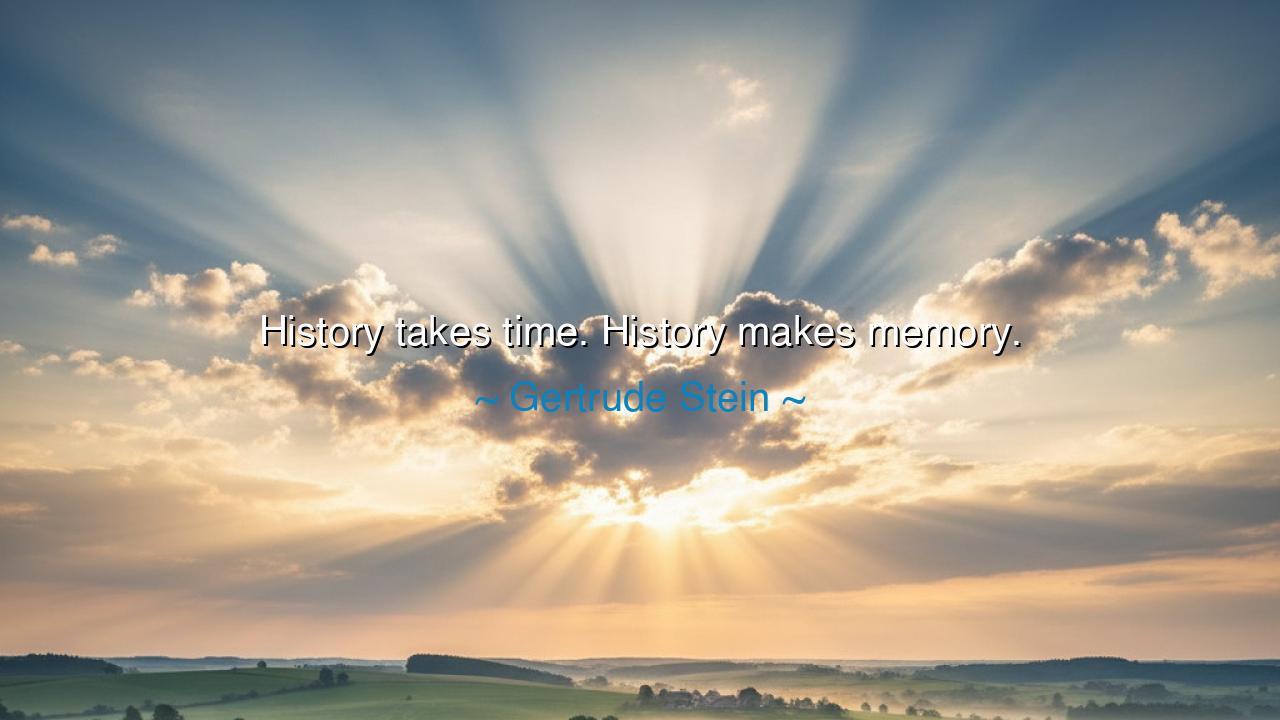
History takes time. History makes memory.






In the measured and deliberate voice of Gertrude Stein, we find the wisdom of one who understood both the rhythm of words and the rhythm of existence: “History takes time. History makes memory.” These two sentences, simple yet eternal, hold the essence of human continuity. They remind us that the unfolding of life—its triumphs, its tragedies, its transformations—cannot be rushed. History is not merely what happens; it is what endures, what is shaped slowly by the passage of time, and what, in its quiet patience, gives birth to memory. For memory is the echo of history in the human heart, and time is the sculptor that gives it form.
To understand this, one must know something of Gertrude Stein herself. She was a woman who lived between worlds—between the 19th and 20th centuries, between continents, between art and philosophy. In Paris, she gathered around her the brilliant lights of her age: Picasso, Hemingway, Matisse. She saw, with the eyes of a poet and the mind of a philosopher, that all great creation—whether in art, in civilization, or in the soul—requires time. Just as a seed does not bloom in an instant, neither does history reveal its meaning in the moment it occurs. It must ripen. It must be lived, remembered, and retold. Only then does it become part of the world’s memory.
Think of the fall of Rome—that mighty empire whose grandeur once seemed eternal. At the time of its collapse, its people saw only ruin, fear, and disarray. But centuries later, history transformed that chaos into meaning. The fall became a lesson about corruption, power, and renewal. The pain of an age became the memory of a civilization. Time, like a great river, washed away the noise of the moment, leaving behind only what was worth remembering. Thus Stein’s words remind us: “History takes time.” It is not made by those who shout the loudest, but by those whose deeds survive the silence of years.
In this, there is both humility and hope. We live in an age that craves immediacy, that demands meaning before time has ripened it. Yet the ancients knew, as Stein knew, that understanding must wait upon the patience of the ages. The historian Thucydides, writing of the Peloponnesian War, did not rush to judge; he wrote for “those who will come after.” He knew that only distance reveals truth, and that memory—not mere record—is what transforms events into wisdom. What is today confusion may tomorrow be clarity. What seems insignificant now may become the cornerstone of remembrance.
There is a secret law that governs both history and the heart: time sanctifies. When we look back upon our lives, we see that the moments which once felt unbearable have become the very threads of meaning that shape who we are. Our own histories take time to become memory. They, too, must pass through pain, reflection, and forgiveness before they can teach us what they were meant to teach. As nations must endure generations to find their story, so too must each soul endure years to find its truth.
Stein’s words are a gentle admonition to all who despair that their efforts are unseen, that their time is wasted, that the world forgets too easily. She whispers to them: be patient. For the work you do, the love you give, the struggles you face—these are all threads in the vast tapestry of time. History is weaving still, and memory has yet to speak. Do not seek to be remembered too soon, for remembrance without depth is as fleeting as breath.
So let this be the lesson we pass down: honor the patience of time. Do not demand meaning before it has matured. Live well, and trust that your days, however ordinary they may seem, are the raw material of history and memory alike. When you act with purpose, even the smallest deed becomes part of the great unfolding story of humankind. For time will take what you do and shape it into something that endures. And when the centuries look back, they will see not chaos, but pattern; not dust, but legacy.
In this way, Gertrude Stein teaches us that to live is to participate in eternity’s slow creation. History takes time, and history makes memory—and in that cycle, all that is worthy of remembrance finds its home.






AAdministratorAdministrator
Welcome, honored guests. Please leave a comment, we will respond soon